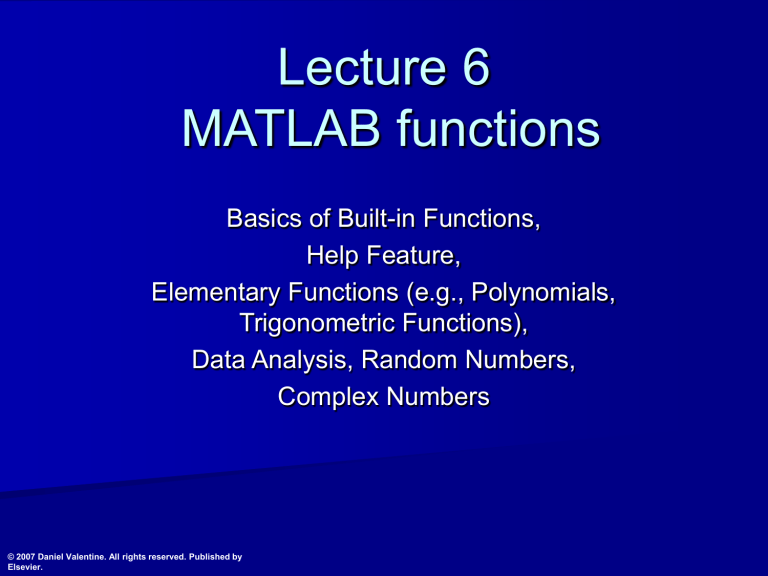Hahn\Lectures\lect06_matlab_functions

Lecture 6
MATLAB functions
Basics of Built-in Functions,
Help Feature,
Elementary Functions (e.g., Polynomials,
Trigonometric Functions),
Data Analysis, Random Numbers,
Complex Numbers
© 2007 Daniel Valentine. All rights reserved. Published by
Elsevier.
What is a built-in function?
A computational expression that uses one or more input values to produce an output value.
MATLAB Functions have 3 components: input , output , and name b = tan( x ) x is the input , b is the output , and tan is the name of a built-in function ; in this case, it is the tangent function with argument in radians.
MATLAB functions
Functions take the form: variable = function(number or variable)
MATLAB has many functions stored in its file system.
To use one of the built-in functions, you need to know its name and what the input values are.
For example, the square root function : sqrt() .
Find the square root of 9 using MATLAB
HELP feature
You may not always recall the name and syntax of a function you want to use since
MATLAB has so many built-in functions.
MATLAB has an indexed library of its builtin functions that you can access through the help feature.
If you type help in the command window
MATLAB provides a list of help topics.
Help
In MATLAB command window type
If we are interested in the elementary mathematics functions, we find it on the list of help topics (5 th down) and click it.
A list of commands appears with the description of what each one does.
Try a few!
MATLAB Help
More Help
For more specific help: help topic
Check it out:
MATLAB describes what the function tan does and provides helpful links to similar or related functions to assist you.
Hands-on
Use MATLAB help to find the exponential, natural logarithm, and logarithm base 2 functions.
Calculate e 7
Calculate ln(4)
Calculate log
2
(12)
Help Navigator
Click on Help on the tool bar at the top of
MATLAB, and select MATLAB Help .
A HELP window will pop up.
Under Help Navigator on the left of screen select the Search tab.
You can Search for specific help topics by typing your topic in the space after the : .
You can also press F1 on your keyboard to access the windowed help.
Help Navigator window
Elementary Mathematical Functions
MATLAB can perform all of the operations that your calculator can and more.
Search for the topic Elementary math in the Help Navigator just described.
Try the following in MATLAB to continue your exploration of MATLAB capabilities ans=3 ans=1.9459
Of course, try a few others.
Rounding functions
Sometimes it is necessary to round numbers. MATLAB provides several utilities to do this.
round(x ) fix(x ) floor(x ) ceil(x )
What do they do?
Try the exercises above with y in place of x .
Discrete-mathematics functions
What do these functions do?
If you are not sure, use the help feature.
Trigonometric functions
MATLAB can compute numerous trigonometric functions, for angles in radians.
To convert degrees to radians, the conversion is based on the relationship:
– 180 degrees = pi × radians
Note: pi is a built-in constant in MATLAB.
REMARK: Numerical computations with decimal-point numbers are only approximate (just like your calculator).
If you try to find sin(pi) , MATLAB will not return 0 as expected, but rather 1.2246e-016.
Hands-on
Use MATLAB to find the sine of 360 degrees.
Use MATLAB to find the arccosine of -1 in degrees (the help function may be handy).
Use MATLAB to find the inverse tangent of x as x ranges from -1 to 1 in steps of 0.1.
Data analysis functions
It is often necessary to analyze data statistically.
MATLAB has many statistical functions: max() min() mean() median() sum() prod() sort() sortrows() size() length() std() var()
Data analysis practice
What is the largest number in vector x and where is it located?
[ value,position ] = max(x ) value = 10 position = 4 highest value is 10 located in the 4th column
What is the median of the above vector?
median(x ) ans = 5
What is the sum of the above vector?
sum(x ) ans = 29
Hands-on
Sort v in descending order.
Find the size of y.
Find the standard deviation of v.
Find the cumulative product of v.
Sort the rows of y based on the 3 rd column.
Generation of random numbers
rand(n) produces an n×n matrix of random numbers from 0 to 1.
rand(n,m) produces an n×m matrix of random numbers between 0 and 1.
To use MATLAB to produce a random number between 0 and 40, do the following:
Complex numbers
Complex numbers take the form of a+b*i :
– a is the real part
– b is the imaginary part where i = sqrt(-1).
Complex numbers can be assigned in
MATLAB on command lines as follows:
>> a = 2; b = 3; % Must assign a & b before
>> c = a+b*i % assigning c as shown
>> c = complex(a,b) % or this other way.
Complex numbers continued
To find the real and imaginary components of a complex number: real(c) imag(c)
To find the absolute value or modulus of a complex number: abs(c)
To find the angle or argument expressed in radians of a complex number: angle(c)
Other useful functions
clock : produces an array that tells year, month, day, hour, min, sec.
date : tells date pi : the number pi (3.141592653589…..) i : imaginary number % i = sqrt(-1) j : imaginary number % j = sqrt(-1) eps : smallest difference between two numerically-computed, adjacent real
(‘floating point’) numbers = 2.2204e-016.
Exercises
Find the modulus (magnitude, abs) and angle
(argument) of the complex number 3+4i.
Generate a 4x4 array of random numbers between 0 and 10. Sort each column of the array.
Use MATLAB’s help function to find built-in functions to determine:
– The base 10 logarithm of 5
– The secant of pi
Summary
Help Feature
Basic Math Functions
Rounding Functions
Discrete Mathematics Functions
Trigonometric Functions
Data Analysis
Random Numbers
Complex Numbers







